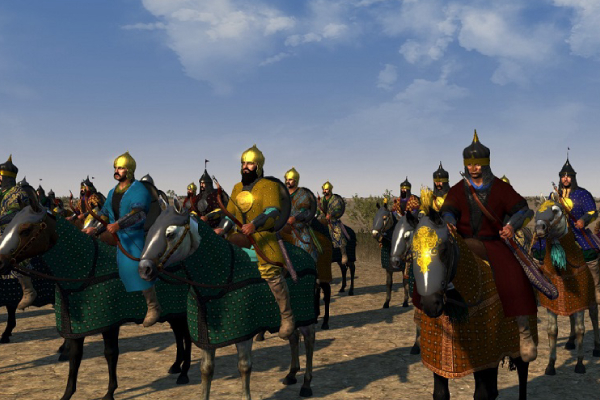These two confederations, known as the ‘’Black’’ and ‘’White’ sheep respectively, were groups which had originally formed part of the eleventh and twelfth century Central Asian immigration, and had settled in eastern ANatolla which became a ‘’sink’’ for turbulent and unwanted nomads. With the disintegration of the Mongol II Khan empire the Qara Qoyonlu were able to expand and control northwest Iran and much of Iraq, and although they bowed to Timur’s approach, they were able to hold on to the area and block any effective western Timurid aspirations.
The Aq Qoyonlu were situated further west in Anatolia, but after 1469 they were able to expand eastwards into Iran having defeated the Qara Qoyonlu and effectively controlled Iran and Iraq down to the Persian Gulf. They were mainly concerned with fighting the Ottomans and Anatolia, and were eventually crushed by these and the rising Safavid power.
One interesting feature of these turkmen confederations was their religious affinities. The Qara Qoyonlu were predominantly of the Shi’ite party, whereas the Aq Qoyonlu were Sunni Muslims, and it has been suggested that one of the reasons fo the eventual fall of the Aq Qoyonlu was the spread of Shi’ite propoganda among the various Turkish tribes in Anatolla by Safavids.
Of the monuments which can definitely be assigned to these confederations, the most important is the Blue Mosque at Tabriz. This mosque is particularly fascinating because of its plan and also because of the beautiful blue tile mosaic which gives it its name. The plan is unusual for Iran in that it is a covered mosque as opposed to a courtyard one, and the central dome is surrounded by a series of small domes, quite unlike any contemporary Iranian building, but strongly related to the Ottoman mosques. Thsi would certainly seem to indicate a major Anatolian connection through to the main Ottoman centers in western Turkey, as might well be expected given the common language and orgins.
The decoration of the Blue Mosque attained an incredible richness with deep lapis lazuli blue as the foundation upon which a series of carved arabesques wandered. Much of this is now destroyed, but enough remains to attest the skill of the craftsmen. The upper section of the mihrab chamber was entirely covered with a deep blue mosaic on which patterns were stencilled on gold, below which was a dado of immense slabs of alabaster.
Other Turkmen monuments in Iran include the Darb-i Imam shrine at Isfahan, some fine tilework in the Maydan Mosque at Kashan, and the tile mosaic in the courtyard of the Isfahan Jami’ Mosque. All of this, however can be regarded as a continuation of the Timurid style which was maintained in the eastern Iran until the end of the fifteenth century. The Ottoman-style plan of the Blue Mosque was a unique importation and had no major progeny in Iran, so that the Turkmen contribution to Iranian architecture lay mainly in continuing and maintaining already established traditions.
Already during the fifteenth century many of the extreme Timurid characteristics, the high dome and monumental scale, had been refined by Persian influence within Iran proper. the sixteenth and seventeenth centuries were to see the triumph of Persian style and taste under major native dynasty, which paradoxically was Turkish speaking, but which emphasized its Iranian antecedents and sought to reform and consolidate the country as an Iranian entity.
The Safavids 1501 – 1732
In the early part of the fourteenth century Shaykh Safi established the Sufi order of the Safawiyya at Ardabil in Azarbayjan. This order flourished among the Turkic tribes in that area, and although it was probably Sunni in origin, the area has a historic tradition Shi’ism, and by the middle of the fifteenth century, at which time an intense propoganda was carried out among the tribes, and then leader was able to seize Azarbayjan from the Aq Qoyonlu in 1501, and withinf ten years was master of the whole of Iran, which he ruled as Shah Isma’il, and founded the Safavid monarchy.
Shah Isma’il was not only temporal ruler of the country, but also a major spiritual leader claiming descent from the family of the Prophet and an exalted status as representative of the Shi’i Imams. These ideas were accepted by their tribal followers, known as Qizil Bash because of the red caps they wore, and therefore Shi’ism became the state religion to which most of the population eventually adhered, although Azarbayjan was always a center of religious controversy. This policy also had a major political reason in that the Ottomans were devout Sunnis, and the religious difference helped to create a rallying point around which Iran was able to become a nationaly entity, and which has enabled it to survive practically unchanged geographically into modern times. The new Safavid state was surrounded by potential enemies, the Ottomans to the west, the Ozbegs to the northeast, and even at times the Mughals to the east. All of these were Sunnis and unrelenting in their hostility to the new Shi’i regime. As a result the northeast and northwest borders were in a constant state of flux, and it was judged advisable to move the capital from Tabriz, which was vulnerably near the Ottomans, firstly to Qazvin and then to Isfahan, but the central heart of the country was forged into a permanent unity.

